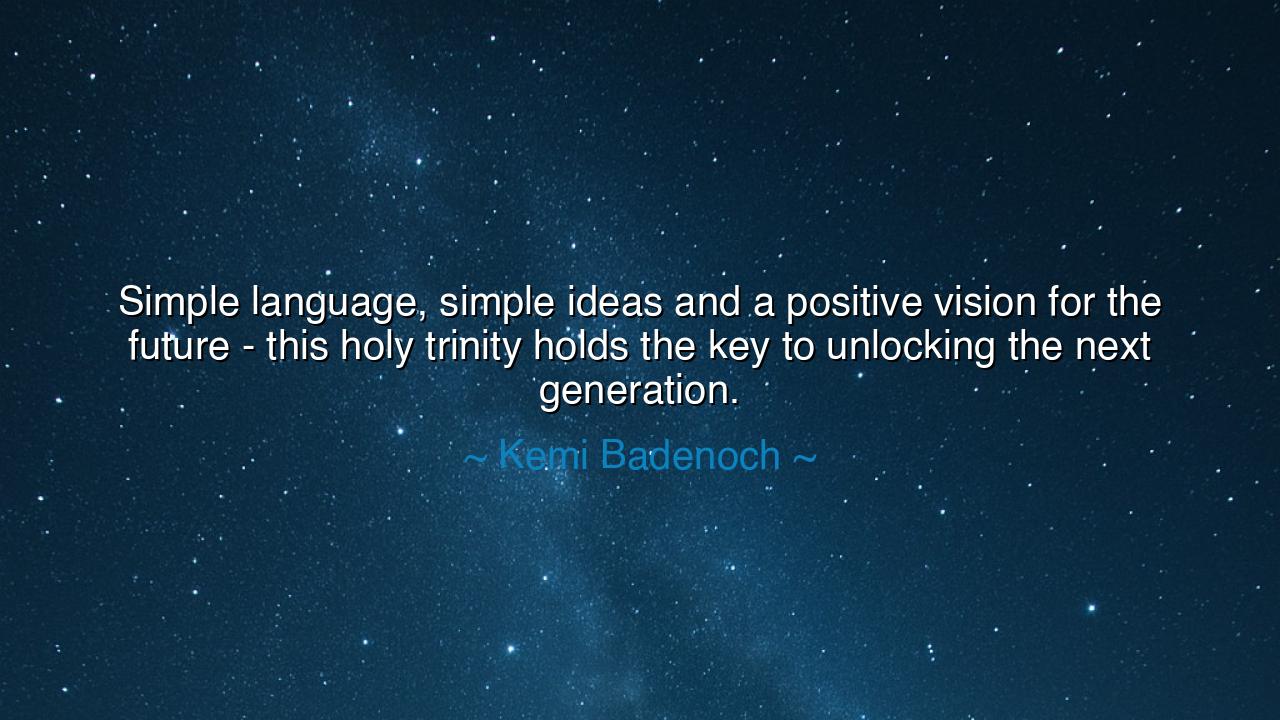
Simple language, simple ideas and a positive vision for the
Simple language, simple ideas and a positive vision for the future - this holy trinity holds the key to unlocking the next generation.






When Kemi Badenoch proclaimed, “Simple language, simple ideas and a positive vision for the future – this holy trinity holds the key to unlocking the next generation,” she spoke with the voice of a teacher and a builder of nations. Her words remind us that the true strength of leadership and inspiration lies not in complication, but in clarity. To guide a people, and especially the youth, one must speak plainly, think clearly, and dream brightly. These three — simple language, simple ideas, and a positive vision — form a sacred harmony, a holy trinity capable of shaping the destiny of those yet to come.
The ancients understood this power well. The words of Confucius were not adorned with flowery rhetoric; they were plain, direct, and enduring. His simple phrases on duty, respect, and harmony shaped the spirit of China for millennia. Likewise, the teachings of Jesus of Nazareth were offered in parables — stories of seeds, sheep, and lamps — so that even the humblest villager could grasp truths deeper than the oceans. Simple language opens the heart, for truth is not made greater by obscurity but by accessibility.
In the same way, simple ideas have moved mountains. The call for “liberty, equality, fraternity” during the French Revolution was not a complex philosophy but a clear principle, easy to grasp and powerful enough to shake the foundations of monarchy. Abraham Lincoln, in the midst of America’s great trial, declared at Gettysburg that the nation was “conceived in liberty and dedicated to the proposition that all men are created equal.” Such simple ideas carry force because they touch the deepest chords of human longing. Complexity may confuse, but simplicity unites.
Yet language and ideas alone are not enough. Badenoch reminds us of the need for a positive vision for the future. For what use are words and ideas if they do not lift the eyes beyond despair? A generation without vision withers like crops in drought. But when vision is offered — radiant, hopeful, believable — the young rise with courage. Think of Martin Luther King Jr., who did not offer only criticism of injustice, but a dream, a shining image of children of all colors walking hand in hand. It was this positive vision that ignited hope and gave strength to endure.
The heart of this teaching is the marriage of simplicity and hope. Complexity divides, while clarity gathers. Negativity paralyzes, while positivity inspires. A people guided by plain words, clear ideas, and a radiant vision become unstoppable, for they know not only where they stand but where they are going. Badenoch’s “holy trinity” is not merely political strategy; it is the timeless blueprint of every enduring movement in human history.
The lesson for us is clear: if we wish to reach others — especially the young — we must cast aside the temptation to impress with complication. Instead, we must speak plainly, think clearly, and dream boldly. Our words must be understandable, our ideas must be graspable, and our vision must be unifying. By this we do not merely influence minds; we ignite spirits.
In practice, this means choosing simplicity in our speech and honesty in our teaching. It means stripping away prideful complexity and finding the core truths worth passing on. It means encouraging the young not with fear of the world, but with faith in their future. And it means carrying a vision of hope into every conversation, every classroom, every home.
Therefore, let us hold fast to Kemi Badenoch’s wisdom: the holy trinity of simple language, simple ideas, and a positive vision is the key that unlocks hearts, inspires courage, and shapes the next generation. Speak it, live it, and embody it — and your legacy will not fade, for it will be written into the lives of those who come after you.






VTThi Van Tran
This quote makes me consider the psychological impact of communication. Does framing the future positively shape motivation and resilience in young people? I’m curious whether this approach could be integrated into education, mentorship, or policy-making to cultivate a generation that is both hopeful and capable. How might simple language, simple ideas, and a positive vision work together to create long-term societal benefits?
BNNguyen Hoang Bao Nhi
I feel encouraged by the emphasis on simplicity and positivity, but I also think critically about potential challenges. Could emphasizing simplicity unintentionally underestimate the intelligence or curiosity of the next generation? How do we convey complex realities while keeping messages approachable? I’d like to hear perspectives on finding the right balance between inspiring optimism and preparing young people for real-world challenges.
TTLe Thi thanh
This perspective highlights the role of vision and optimism in leadership. I wonder, though, if simple ideas are enough to inspire meaningful change, or if they must be paired with tangible actions and opportunities. How can mentors and role models translate positive visions into practical steps that young people can take to engage, innovate, and lead?
TDNguyen Thuy Duong
Reading this makes me reflect on the importance of accessibility in messaging. Could complex jargon and abstract concepts alienate the next generation, and how might simplicity make ideas more inclusive? I’d like to explore whether this approach is effective across different cultures and learning styles, or if it needs to be adapted depending on context and audience.
TTThu Thien
I find this idea inspiring, particularly the focus on a positive vision for the future. But it makes me question: how can we ensure that the positivity is realistic and not just idealistic? Are there strategies for combining hope with actionable plans that truly empower young people? I’m curious about examples where simple communication has led to significant social or educational impact.